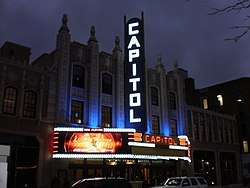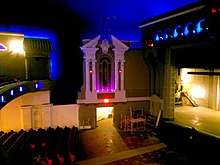Capitol Theatre Building (Flint, Michigan)
The Capitol Theatre Building is a cinema and concert venue located at 140 E. 2nd St. in Flint, Michigan. It opened in 1928 and was listed among the National Register of Historic Places in Michigan in 1985.[3] Designed by John Eberson, it is an atmospheric theater designed to look like a Roman garden.
Capitol Theatre Building | |
 The Capitol Theatre, December 2017 | |
| Location | 140 Second Street, Flint, Michigan |
|---|---|
| Coordinates | 43.0153°N 83.68885°W |
| Built | 1927 |
| Architect | John Eberson |
| NRHP reference No. | 85000165[1] |
| Significant dates | |
| Added to NRHP | January 31, 1985[2] |
| Designated MSHS | August 24, 1984[2] |
History

In 1923, the Flint Building Corporation purchased the lot on which the Capitol Theatre Building sits, for the purpose of constructing a combined theatre and commercial block. In 1924, Col. Walter S. Butterfield announced plans for the construction of a theatre. The Flint Building Corporation met with Butterfield, then reorganized as the Capitol Building Company, with Butterfield as president. Litigation delayed the start of construction, however, and it was not until 1927 that the project started. The building was designed by architect John Eberson, and constructed by Henry Vander Horst of Kalamazoo. The theatre opened in early 1928.[4]
From the day it opened until it first closed in 1976, the Capitol was operated by W.S. Butterfield Theatres which operated several theaters in out state Michigan. In 1957, the theater was modernized in which the lobby and front was extensively remodeled and the atmospheric theater's original colors were painted over and many statues removed.[5] After the theater first closed in 1976, the Barton 3-11 pipe organ was donated to the Flint Institute of Music and was moved to the MacArthur Recital Hall there where it still is today.[6]
In 1977, local grocer George Farah bought the Capitol Theatre Building. Movies were shown and concerts held on and off at the theater until the heating boiler broke down beyond repair forcing the theater to be closed indefinitely in 1996.[7] While the theater was dormant, it was kept in repair and two gas furnaces were installed in front of the stage to keep the atmospheric theater from freezing. The Farah family also started partial restoration work. But under private ownership, the Farah family could not raise enough money for a full restoration.[8]
In April 2015, the Uptown Reinvestment Corp. purchased the downtown Capitol Theatre from Troy Farah. Uptown Reinvestment announced on October 21, 2015 that they had partnered with The Whiting with Uptown restoring the theater and The Whiting managing its operations.[9] On Dec. 7, 2017, the theater reopened.[10]
The restored theater, meeting modern building codes, seats 1,500 with the public areas looking similar to how the theater looked when it first opened in 1928. To aid in the restoration, a non-historic third story addition was torn down to restore balance to the theater's front facade. The 1940s marquee design was replicated utilizing all LED lighting and electronic attraction boards.
The theater reopened with a free event on Friday, December 8, 2017.[11]
Description
The Capitol Theatre Building is a two-and three-story building, housing both a theatre and commercial spaces. It is faced with buff brick accented with glazed terra cotta, with a diverse "fifteenth century Hispano-Italian style" architecture. The facade was originally symmetric, containing a three-story centrally located theater, flanked by two two-story storefront sections on each side. A third story was later added to one of the storefront sections which was removed during the theater building's restoration. The storefront sections have office windows above.[4]
External links
References
- "National Register Information System". National Register of Historic Places. National Park Service. March 13, 2009.
- Staff. "Capitol Theater Building". State Historic Preservation Office. Michigan State Housing Development Authority. Archived from the original on May 28, 2014. Retrieved May 27, 2014.
- Flint Journal file photo (2012-07-31). "Michael Moore says he's helping Flint's Capitol Theatre owners and wants to help movie theaters throughout Michigan". MLive.com. Retrieved 2014-06-02.
- J.M. Davis (April 1984), National Register of Historic Places Inventory-Nomination Form: Capitol Theatre Building, File Unit: National Register of Historic Places and National Historic Landmarks Program Records: Michigan, 1964 - 2013
- "10 historic moments of Flint's Capitol Theatre, in line for $21M rehab". 2015-04-18.
- "History". ftoc.org.
- "Flint Capitol Theater - The Concert Database". theconcertdatabase.com.
- "The Capitol Theater A building in Transition". My City Magazine. 4 January 2016.
- Ketchum III, William E. (October 21, 2015). "Uptown, The Whiting partner for Capitol Theatre relaunch in downtown Flint". Flint Journal. MLive Media Group. Retrieved May 24, 2018.
- May, Jake (December 7, 2017). "Tour Flint's newly-restored, historic Capitol Theatre". Flint Journal. MLive Media Group. Retrieved May 24, 2018.
- "Celebrate the season in song at The Capitol Theatre". NBC25/FOX66. 2017-11-17.
| Wikimedia Commons has media related to Capitol Theatre (Flint, Michigan). |